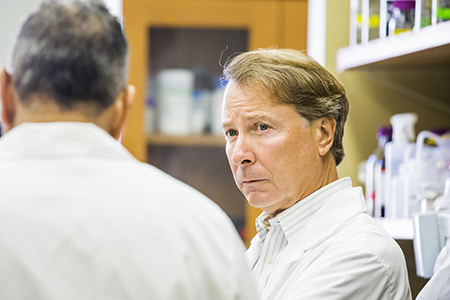An expensive and complicated journey


February 2016
Bringing a new drug to market is one of the most difficult propositions in science — partly because so much of the process takes place outside the lab.
“It’s not something we are taught in school,” said College of Medicine neuroscientist Pradeep Bhide, who has spent nearly 10 years developing a novel treatment for attention deficit hyperactivity disorder.
With support from Florida State University, Bhide created a startup company, Avekshan LLC, in 2012 as a first step into the business of developing a new drug. As with any similar startup company, Avekshan faced one particularly challenging problem. Synthesizing a drug and gaining Food and Drug Administration approval based on animal and human toxicity studies and clinical trials is a multiyear proposition costing millions of dollars.
There’s good science but no guarantee that the drug will work as designed, and universities aren’t funded to dabble in risky business ventures. While Florida State has a stake in the intellectual property behind Avekshan, it cannot fund the path to FDA approval.
Avekshan’s proposal is to produce a nonaddictive ADHD drug.
“The current treatments, although they are very effective, are highly abused,” Bhide said. “We all know, especially on college campuses, students abuse stimulants. Stimulants are the standard treatment for ADHD.
“So even though they are available, even though they are effective, many physicians hesitate to prescribe these drugs, and many parents don’t want their child to take a drug that’s potentially addictive or can be abused.”
That means many children with ADHD don’t get medication they need, especially in countries such as the U.S. where all stimulants are treated as controlled substances.
Tallahassee businessman Rick Kearney, who describes himself as a “serial entrepreneur,” is providing the financial investment that will allow Avekshan to see if its proposed new ADHD medication can be safe and effective in humans.
“Really, an investor is looking at the people as much as the technology or the product itself,” Kearney said. “So when Pradeep was introduced to me and I met his team, and the product itself and the research that they had done, it really was a combination of all of those things that made this attractive.”
Kearney, a graduate of the University of West Florida, has a history of investing in Florida State research. He backed a “solar collector” that takes heat from the sun and transfers it through a liquid medium to generate electricity, which was developed and proved effective. He’s also investing in a material that could be used in the rapid regeneration of skin cells to treat people with wounds that currently are difficult to recover from.
“Any community has a strong link with its academic institutions,” Kearney said. “Florida State generates a lot of revenue, a lot of ancillary business, that vitalizes our community, and I think the community needs to likewise appreciate what this university means to them.
“Whether it’s the technology that’s happening here at the College of Medicine or at the Mag Lab, or in engineering, we really need to try to harness that intellectual property and keep it here in Tallahassee.”
Bhide is hopeful that Avekshan’s new drug will be approved by the FDA; that an animal toxicity and safety study may begin by later this year; and that human safety studies could be underway sometime in 2017. Including clinical trials, the process is likely to take a minimum of three to four more years – if everything runs smoothly.
“We haven’t overcome those huge hurdles yet. We’re waiting for that to happen,” said Deirdre McCarthy, who joined Bhide’s research lab at Massachusetts General Hospital and Harvard Medical School, Boston not long after emigrating from Ireland.
“There’s a phrase we use at home — ‘It’s a small wall, you can easily climb over it.’ Whatever it is, it’s not something that’s going to stop you.”
She said Kearney’s investment makes the prospect of being able to help millions of children seem within reach.
Bhide began to visualize the potential target for a drug to treat symptoms of ADHD and related neuropsychiatric disorders while collaborating with clinicians at Massachusetts General. Creating a business was the furthest thing from his mind.
“In some ways you do what you are really passionate about,” he said. “You don’t do it only because you think there’s a commercial potential. It’s whatever you feel really committed to, and in our case that’s children’s cognitive health and solving the mysteries of brain development.”
For more about the disorder, visit nimh.nih.gov and search keyword “ADHD.”
For more about Rick Kearney, visit http://rickkearney.com/.

